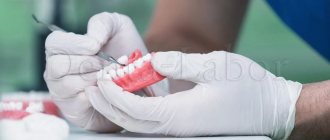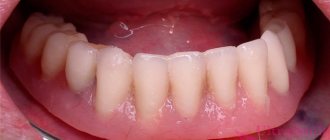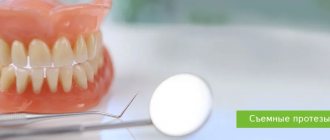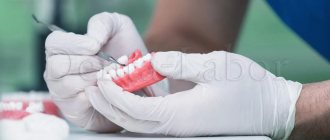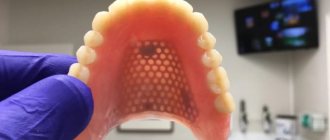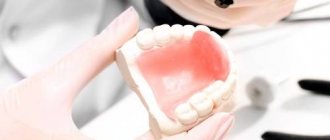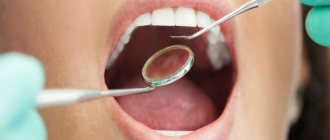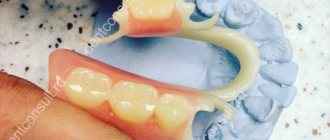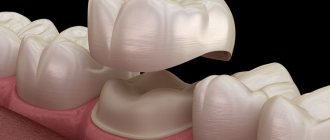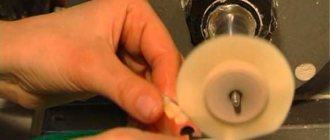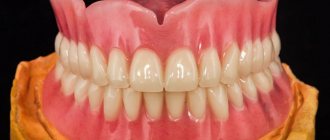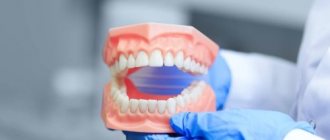999
Biologically passive thermoplastics of medical purity are increasingly being used for the manufacture of artificial organs and individual body structures.
The most famous and most popular thermoplastic for creating the basis for removable dentures is polyamide, patented under the Deflex brand.
Polyamide is developed by the Argentine company NUTEN as a material for the manufacture of the base of removable structures.
Features of the material
Deflex is a polyamide with a high elasticity index, which allows this material to be classified as a semi-rigid thermoplastic.
This feature gives polyamide significant advantages, and puts prostheses based on it an order of magnitude higher than nylon analogues in many characteristics.
Thus, the material has increased temperature stability , and reacts completely differently to temperature changes. Deflex, as is usually the case with nylon, does not harden when eating cold foods and does not soften when eating hot foods.
The simultaneous combination of the maximum density of polyamide with its minimum porosity provides high levels of strength, stability and durability of prosthetic products based on it.
And the low absorption of all kinds of liquids blocks the formation and fixation of bacterial plaque on the surface , the appearance of odor, and prevents distortion of the color of the structure.
The increased strength and elasticity of the material makes it possible to make a device whose thickness will be at least half that of acrylic, which guarantees it comfort when wearing, lightness, and preservation of the patient’s natural phonetics.
In addition, with such characteristics it was possible to distribute the chewing load evenly, prevent the formation of a shoulder load on the supporting elements and ensure the vertical stability of the entire structure.
Polyamide is a hypoallergenic material , which means it is ideal for patients who are prone to all kinds of allergic manifestations. Deflex is also distinguished by its natural transparency, which makes products based on it completely invisible.
Important! A unique combination of creation technology and material allows us to produce a functional prosthesis with ideal aesthetics. Such products comply with the Kennedy classification, combining 5 main functional properties - stability, support, retention, bending and occlusion.
The first signs of an allergy to dentures and ways to get rid of the problem.
Visit here to learn more about contraindications for removable dentures.
At this address https://www.vash-dentist.ru/protezirovanie/semnyie-p/vidyi-klammerov.html we will consider the types of retaining clasps.
Areas of use
The area of use of polyamide prostheses is quite wide. It is appropriate to install such products in patients with the following indications:
- minor defects in the dentition, when 1-2 elements are missing;
- edentia, i.e. not a single tooth survived;
- allergic reaction to metal alloys.
Deflex dentures are also successfully used for patients suffering from periodontal disease or periodontitis, since there are no conditions for loosening of supporting teeth.
It is also advisable to recommend them to those for whom preparation is strictly contraindicated.
Polyamide structures are ideal for people who have traumatic professions, for example, firefighters, police officers, athletes, etc., since it is almost impossible to break them.
It is also recommended to choose Deflex for people who, due to certain restrictions, are contraindicated for implantation.
Such pathological conditions include:
- heart failure;
- thyroid problems;
- immune system diseases;
- hepatitis;
- diabetes;
- blood diseases.
A little about the manufacturer
Dental Import Export Company Dentimex was founded in the Netherlands in 1938. The company began its activities with the production of removable products made from acrylic materials.
A gradual increase in the product range, expansion of production capacity and the conquest of new markets led to the reorganization of the manufacturer and its focus on the production of high-quality innovative premium materials for the manufacture of dental structures.
Currently, Vertex-Dental is known in more than 75 countries around the world. It is engaged in the production and distribution of various components for the manufacture of structures:
- hot and cold curing plastics;
- insulating liquids;
- polishing materials.
Particularly popular in orthopedic dentistry is the monomer-free plastic Vertex Thermosens, which makes it possible to produce systems for patients with increased sensitivity and susceptibility to allergic reactions.
Contraindications
Important! Removable devices, including polyamide ones, have virtually no contraindications for use.
They should not be worn by people suffering from:
- pathologies of bone tissue;
- mental disorders;
- oncology;
- acute or chronic inflammatory diseases in the body.
It is also not recommended to install them if you are depressed, pregnant, drug addicted, or undergoing radiation therapy.
Why dentures may become loose and what specialists are doing.
In this publication you will find detailed information on the adequate selection of abutment teeth.
Here https://www.vash-dentist.ru/protezirovanie/semnyie-p/raznovidnosti-bazisov-zubnyih.html all the most important things about creating the basis of a partial removable denture.
Who is it suitable for?
Nylon denture systems can be installed to either recreate missing teeth or cover existing but unsightly ones. The use of prostheses is indicated in the following cases:
Products are installed if one or part of the teeth in the jaw is lost; they are installed in cases of complete edentia - the absolute absence of teeth. They are used when, for financial reasons, it is impossible for a patient to have implantation and installation of clasp types of prostheses.
Indicated when implants are prohibited from being implanted into a patient due to the presence of various diseases. Although nylon prostheses can be used even with existing diabetes, disorders of the cardiovascular system, even epilepsy and other diseases.
Nylon structures are often recommended for installation by children. They are used in situations where a baby tooth has been removed and a permanent replacement does not appear for a long time. In this case, prosthetics prevent the displacement of a number of teeth in the jaw and subsequent deformation of the bite.
Used in the presence of pathology such as periodontal disease. This untreated disease can lead to the loss of all teeth. Wearing a prosthesis is indicated only in the first and second stages of the disease.
Used for temporary prosthetics during the period of tissue adaptation during implantation.
Dentists sometimes recommend wearing them for people involved in dangerous work, a high risk of various injuries, including damage and loss of teeth: athletes, employees of the military and law enforcement agencies, and others.
Advantages and disadvantages
To understand all the features of the new generation designs, it is necessary to name their main advantages.
These products, in comparison with analog products made from other materials, have the following qualities:
- Adequately distributes the chewing load.
- Not subject to change due to temperature fluctuations.
- Stable in the oral cavity.
- They have good suction to the gums and retention, i.e. Fixed perfectly to the palate and gums.
- They have a short adaptation period.
- They do not cause discomfort to the gums and soft tissues, which means they do not cause irritation.
- Comfortable to use as they are light in weight.
- Durable and easy to care for, do not require the use of special cleaning agents.
- If the operating rules are followed, the dentures do not break. Microcracks do not form on their surface if accidentally dropped.
- They are not absorbed by intraoral fluids or odors and retain their original color.
- Shows perfect aesthetics.
- They do not change the taste perception of food.
Important! Polyamide prostheses under the Deflex brand do not have the disadvantages that are inherent in analogue products made from acrylic or nylon.
The disadvantages of the structures under consideration are isolated. It should be noted:
- High cost. Not all patients can afford to install a polyamide prosthesis, so the selection of the design should be done with a specialist, taking into account all the features of the clinical case.
- Little fame. Since the material is new and has been used in dentistry relatively recently, not all clinics can offer their clients products based on it.
- Impossibility of repairs. In the event of a breakdown, polyamide devices cannot be repaired (glued or welded) and will require re-prosthetics.
Kinds
Among the variety of prostheses, they are divided into:
- partially removable;
- completely removable structures;
- conditionally removable.
Fully removable systems are most often used for complete tooth loss. They are created from individual casts, taking into account all the anatomical features and structure of the patient’s jaw.
They are made to be as comfortable as possible and the recommendation is not to take them off at all for the first time. During the test period of wear, the body gets used to it, and the doctor monitors the patient’s reaction to the prosthetics.
If necessary, the dentist makes adjustments and adjusts the design of the prosthesis, which makes wearing them more comfortable and painless. This type of removable denture looks very natural. They are made from the following materials: nylon, plastic. Please note that the structures are non-toxic and do not cause harm to health.
Conditionally removable dentures are recommended for the loss of one tooth. Such medical systems do not need to be removed before going to bed. They are attached to adjacent teeth using special cement; metal hooks and glue are also used for fastening.
Partially removable types of structures are not the most convenient. They attach to the gums and take up a lot of space in the mouth. This option is suitable for permanent wear, on a temporary basis and can replace one or more teeth. The technology is not perfect, but its financial accessibility makes it popular today.
Installation steps
The manufacture and installation of any model of removable systems is faster and easier than non-removable products. The entire process of restoring missing teeth can be divided into 2 stages: clinical and laboratory.
The clinical stage includes the following activities:
- Study of anamnesis . The doctor interviews the patient about his state of health, living conditions and occupation, studies his medical record in detail, and also finds out whether he has had experience with prosthetics and how comfortable the device was.
- Instrumental examination of the oral cavity, which determines the condition of the mucous membrane, remaining dental units, chewing muscles, and the quality of oral hygiene.
The sensitivity of teeth is assessed, the symptoms of dental pathologies are identified and the degree of their severity is determined. - Hardware examination of the dental system. Before prosthetics, CT (computed tomography), orthopantomogram, radiovisiography, MRI are used
- MRI (magnetic resonance imaging). The results are necessary to determine the limitations or indications for prosthetics, the choice of technique for restoring the dentition and the type of structure.
Thanks to a complete examination of the dental system, a specialist can identify hidden dental pathologies, obtain information about the quality, density and volume of the jaw bone, the condition of the alveoli, dental roots, periodontal tissues and the temporal joint. - Preparing the oral cavity . Hygienic cleaning, removal of remaining roots that cannot be restored and impacted dental elements, and treatment of identified pathologies (inflammation, caries, etc.) are required.
- Selecting a removable device model. Taking into account the number of remaining teeth, the condition of the oral cavity, and the location of the defect, the orthopedic dentist selects a design model.
- Receiving an impression. Using silicone or alginate mass, an impression of both jaw arches is made.
After the impression arrives at the laboratory, the laboratory stage of prosthetics begins. The entire creation process takes place in the following sequence:
- The impression technician casts models of both jaws (entirely or only certain areas), from which the prosthetic product will later be made.
- The specimens are secured so that the position corresponds to the patient's centric occlusion. To avoid making mistakes, an occlusal roller is made, which is sent to the dentist to determine the patient’s occlusion.
- The model is fixed on the articulator. In this position, a model of the future prosthesis is cast from plaster. The cushion is removed and artificial teeth are placed in its place.
- The sample is sent for the first fitting , during which the correct selection of the shade of artificial teeth to real ones and the accuracy of closure of the jaw arches are tested.
- Fit. After checking, the model is returned to the laboratory, where the technician, taking into account all the comments, forms the final version of the design.
The finished product is tried on again for the patient. It should fit perfectly in all respects. If deficiencies are found, the design must be adjusted.
Watch the video to see how the Deflex prosthesis is made.
Possible breakdowns
Damage to the integrity of Vertex products is quite rare, however, dentists identify the following situations in which product repair may be required:
- chipping or loss of an artificial tooth is eliminated in a dental laboratory by installing a new element of the row;
- if the product adheres poorly to soft tissues, adjustment of the base may be required;
- Elimination of a broken lock is carried out by replacing it with a new one;
- When cracks or breaks in the base appear, it is repaired or a new structure is made.
Dentists pay attention that repairs should only be carried out by specialized specialists. Independent actions can cause even more damage to the structure.
Price issue
In large clinics, the cost of restoring teeth with a complete Deflex denture varies from 40 to 70 thousand rubles. The final price depends on the following points:
- the amount of treatment performed before installation;
- method of fastening the structure;
- specialist qualification;
- status and pricing policy of the clinic.
Partial models will naturally be 15-25 thousand rubles cheaper. A design that will replace only 1-3 teeth costs no more than 15 thousand rubles.
Reviews
Deflex polyamide prostheses are new and are still little known. But their use in dental restoration allows one to avoid the disadvantages that are characteristic of analogue structures made of nylon or acrylic.
You can talk about your experience of restoring missing teeth using Deflex dentures and your impressions of them by leaving a comment on this article.
If you find an error, please select a piece of text and press Ctrl+Enter.
Tags prosthetics removable dentures
Did you like the article? stay tuned
Previous article
For what purposes are temporary dental implants used?
Next article
Treatment of dental anomalies using the Schwartz apparatus
Disadvantages of a nylon prosthesis
Like any other dental device, soft nylon dentures also have their disadvantages. First of all, the price: the cost of such dentures is slightly higher than the cost of a traditional denture. Comfort and aesthetics come at a price. It should also be noted that since the nylon denture does not have metal parts resting on other teeth, the entire load is distributed on the gums. Therefore, it is very important to monitor changes in the shape of the gums due to use, and reline the prosthesis in a timely manner. If not properly cared for, scratches may occur on the prosthesis. Also considered a disadvantage is the long production period.
Thus, although a nylon denture has both pros and cons, it can be used to provide high-quality, reliable and comfortable dentures. Consult your dentist and he will help you choose the most suitable option.
